Updated answer (2): just use fixfacets()
I've put together a function fixfacets(fig, facets, domain_offset) that turns this:

...by using this:
f <- fixfacets(figure = fig, facets <- unique(df$clarity), domain_offset <- 0.06)
...into this:

This function should now be pretty flexible with regards to number of facets.
Complete code:
library(tidyverse)
library(plotly)
# YOUR SETUP:
df <- data.frame(diamonds)
df['price'][df$clarity == 'VS1', ] <- filter(df['price'], df['clarity']=='VS1')*2
myplot <- df %>% ggplot(aes(clarity, price)) +
geom_boxplot() +
facet_wrap(~ clarity, scales = 'free', shrink = FALSE, ncol = 8, strip.position = "bottom", dir='h') +
theme(axis.ticks.x = element_blank(),
axis.text.x = element_blank(),
axis.title.x = element_blank())
fig <- ggplotly(myplot)
# Custom function that takes a ggplotly figure and its facets as arguments.
# The upper x-values for each domain is set programmatically, but you can adjust
# the look of the figure by adjusting the width of the facet domain and the
# corresponding annotations labels through the domain_offset variable
fixfacets <- function(figure, facets, domain_offset){
# split x ranges from 0 to 1 into
# intervals corresponding to number of facets
# xHi = highest x for shape
xHi <- seq(0, 1, len = n_facets+1)
xHi <- xHi[2:length(xHi)]
xOs <- domain_offset
# Shape manipulations, identified by dark grey backround: "rgba(217,217,217,1)"
# structure: p$x$layout$shapes[[2]]$
shp <- fig$x$layout$shapes
j <- 1
for (i in seq_along(shp)){
if (shp[[i]]$fillcolor=="rgba(217,217,217,1)" & (!is.na(shp[[i]]$fillcolor))){
#$x$layout$shapes[[i]]$fillcolor <- 'rgba(0,0,255,0.5)' # optionally change color for each label shape
fig$x$layout$shapes[[i]]$x1 <- xHi[j]
fig$x$layout$shapes[[i]]$x0 <- (xHi[j] - xOs)
#fig$x$layout$shapes[[i]]$y <- -0.05
j<-j+1
}
}
# annotation manipulations, identified by label name
# structure: p$x$layout$annotations[[2]]
ann <- fig$x$layout$annotations
annos <- facets
j <- 1
for (i in seq_along(ann)){
if (ann[[i]]$text %in% annos){
# but each annotation between high and low x,
# and set adjustment to center
fig$x$layout$annotations[[i]]$x <- (((xHi[j]-xOs)+xHi[j])/2)
fig$x$layout$annotations[[i]]$xanchor <- 'center'
#print(fig$x$layout$annotations[[i]]$y)
#fig$x$layout$annotations[[i]]$y <- -0.05
j<-j+1
}
}
# domain manipulations
# set high and low x for each facet domain
xax <- names(fig$x$layout)
j <- 1
for (i in seq_along(xax)){
if (!is.na(pmatch('xaxis', lot[i]))){
#print(p[['x']][['layout']][[lot[i]]][['domain']][2])
fig[['x']][['layout']][[xax[i]]][['domain']][2] <- xHi[j]
fig[['x']][['layout']][[xax[i]]][['domain']][1] <- xHi[j] - xOs
j<-j+1
}
}
return(fig)
}
f <- fixfacets(figure = fig, facets <- unique(df$clarity), domain_offset <- 0.06)
f
Updated answer (1): How to handle each element programmatically!
The elements of your figure that require some editing to meet your needs with regards to maintaining the scaling of each facet and fix the weird layout, are:
- x label annotations through
fig$x$layout$annotations,
- x label shapes through
fig$x$layout$shapes, and
- the position where each facet starts and stops along the x axis through
fig$x$layout$xaxis$domain
The only real challenge was referincing, for example, the correct shapes and annotations among many other shapes and annotations. The code snippet below will do exatly this to produce the following plot:

The code snippet might need some careful tweaking for each case with regards to facet names, and number of names, but the code in itself is pretty basic so you shouldn't have any problem with that. I'll polish it a bit more myself when I find the time.
Complete code:
ibrary(tidyverse)
library(plotly)
# YOUR SETUP:
df <- data.frame(diamonds)
df['price'][df$clarity == 'VS1', ] <- filter(df['price'], df['clarity']=='VS1')*2
myplot <- df %>% ggplot(aes(clarity, price)) +
geom_boxplot() +
facet_wrap(~ clarity, scales = 'free', shrink = FALSE, ncol = 8, strip.position = "bottom", dir='h') +
theme(axis.ticks.x = element_blank(),
axis.text.x = element_blank(),
axis.title.x = element_blank())
#fig <- ggplotly(myplot)
# MY SUGGESTED SOLUTION:
# get info about facets
# through unique levels of clarity
facets <- unique(df$clarity)
n_facets <- length(facets)
# split x ranges from 0 to 1 into
# intervals corresponding to number of facets
# xHi = highest x for shape
xHi <- seq(0, 1, len = n_facets+1)
xHi <- xHi[2:length(xHi)]
# specify an offset from highest to lowest x for shapes
xOs <- 0.06
# Shape manipulations, identified by dark grey backround: "rgba(217,217,217,1)"
# structure: p$x$layout$shapes[[2]]$
shp <- fig$x$layout$shapes
j <- 1
for (i in seq_along(shp)){
if (shp[[i]]$fillcolor=="rgba(217,217,217,1)" & (!is.na(shp[[i]]$fillcolor))){
#fig$x$layout$shapes[[i]]$fillcolor <- 'rgba(0,0,255,0.5)' # optionally change color for each label shape
fig$x$layout$shapes[[i]]$x1 <- xHi[j]
fig$x$layout$shapes[[i]]$x0 <- (xHi[j] - xOs)
j<-j+1
}
}
# annotation manipulations, identified by label name
# structure: p$x$layout$annotations[[2]]
ann <- fig$x$layout$annotations
annos <- facets
j <- 1
for (i in seq_along(ann)){
if (ann[[i]]$text %in% annos){
# but each annotation between high and low x,
# and set adjustment to center
fig$x$layout$annotations[[i]]$x <- (((xHi[j]-xOs)+xHi[j])/2)
fig$x$layout$annotations[[i]]$xanchor <- 'center'
j<-j+1
}
}
# domain manipulations
# set high and low x for each facet domain
lot <- names(fig$x$layout)
j <- 1
for (i in seq_along(lot)){
if (!is.na(pmatch('xaxis', lot[i]))){
#print(p[['x']][['layout']][[lot[i]]][['domain']][2])
fig[['x']][['layout']][[lot[i]]][['domain']][2] <- xHi[j]
fig[['x']][['layout']][[lot[i]]][['domain']][1] <- xHi[j] - xOs
j<-j+1
}
}
fig
Initial answers based on built-in functionalities
With many variables of very different values, it seems that you're going to end up with a challenging format no matter what, meaning either
- facets will have varying width, or
- labels will cover facets or be too small to be readable, or
- the figure will be too wide to display without a scrollbar.
So what I'd suggest is rescaling your price column for each unique clarity and set scale='free_x. I still hope someone will come up with a better answer. But here's what I would do:
Plot 1: Rescaled values andscale='free_x

Code 1:
#install.packages("scales")
library(tidyverse)
library(plotly)
library(scales)
library(data.table)
setDT(df)
df <- data.frame(diamonds)
df['price'][df$clarity == 'VS1', ] <- filter(df['price'], df['clarity']=='VS1')*2
# rescale price for each clarity
setDT(df)
clarities <- unique(df$clarity)
for (c in clarities){
df[clarity == c, price := rescale(price)]
}
df$price <- rescale(df$price)
myplot <- df %>% ggplot(aes(clarity, price)) +
geom_boxplot() +
facet_wrap(~ clarity, scales = 'free_x', shrink = FALSE, ncol = 8, strip.position = "bottom") +
theme(axis.ticks.x = element_blank(),
axis.text.x = element_blank(),
axis.title.x = element_blank())
p <- ggplotly(myplot)
p
This will of course only give insight into the internal distribution of each category since the values have been rescaled. If you want to show the raw price data, and maintain readability, I'd suggest making room for a scrollbar by setting the width large enough.
Plot 2: scales='free' and big enough width:

Code 2:
library(tidyverse)
library(plotly)
df <- data.frame(diamonds)
df['price'][df$clarity == 'VS1', ] <- filter(df['price'], df['clarity']=='VS1')*2
myplot <- df %>% ggplot(aes(clarity, price)) +
geom_boxplot() +
facet_wrap(~ clarity, scales = 'free', shrink = FALSE, ncol = 8, strip.position = "bottom") +
theme(axis.ticks.x = element_blank(),
axis.text.x = element_blank(),
axis.title.x = element_blank())
p <- ggplotly(myplot, width = 1400)
p
And, of course, if your values don't vary too much accross categories, scales='free_x' will work just fine.
Plot 3: scales='free_x

Code 3:
library(tidyverse)
library(plotly)
df <- data.frame(diamonds)
df['price'][df$clarity == 'VS1', ] <- filter(df['price'], df['clarity']=='VS1')*2
myplot <- df %>% ggplot(aes(clarity, price)) +
geom_boxplot() +
facet_wrap(~ clarity, scales = 'free_x', shrink = FALSE, ncol = 8, strip.position = "bottom") +
theme(axis.ticks.x = element_blank(),
axis.text.x = element_blank(),
axis.title.x = element_blank())
p <- ggplotly(myplot)
p









